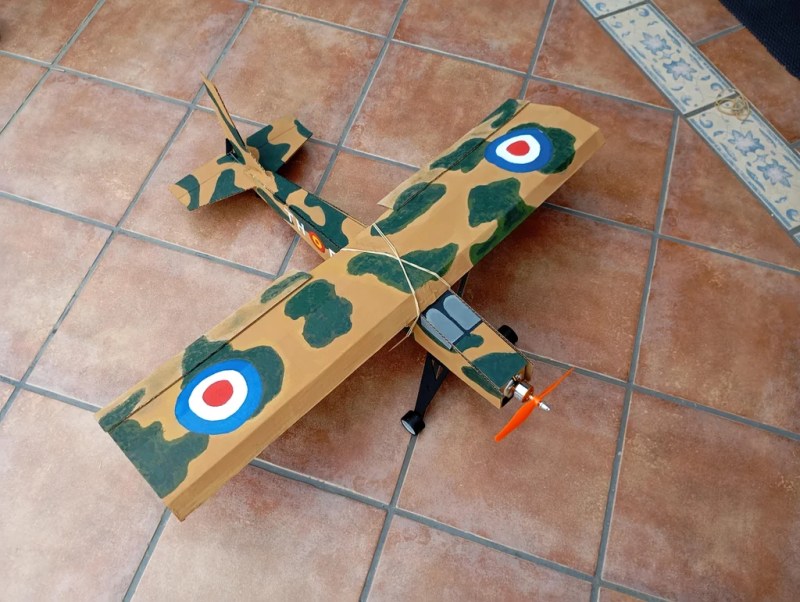Many makers start by building mock-ups from cardboard, but [Alex-08] has managed to build an R/C plane that actually flies, out of cardboard.
If you’ve been thinking of building an R/C plane from scratch yourself, this guide is an excellent place to start. [Alex-08] goes through excruciating detail on how he designed and constructed this marvel. The section on building the wings is particularly detailed since that’s the most crucial element in making sure this plane can get airborne.
Some off-the-shelf R/C parts and 3D printed components round out the parts list to complement the large cardboard box used for most of the structural components. The build instructions even go through some tips on getting that vintage aircraft feel and how to adjust everything for a smooth flight.
Need a wind tunnel instead? You can build that out of cardboard too. If paper airplanes are more your thing, how about launching them from space? And if you’re just trying to get a head start on Halloween, why not laser cut an airplane costume from cardboard?
















My first custom RC plane was made from cardboard and a lot of tape for the seams and hinges. It was a glider though. I didn’t have the kind of money to put a valuable glow engine in something that needed a lot of tweaking before it would fly.
Mostly I pulled it with a short rope while running into the wind. And then steer it downwind and fly it a bit. Not an efficient glider, I couldn’t complete an entire loop around the field. I either lost too much speed or too much altitude.
Why wouldn’t it? You put enough power in the prop and you can make a brick fly.
With a motor that looks to be around 180 Watts maximum power output, and a cardboard plane that weighs less than a kilogram, you’re in the “acrobatic” RC plane category where you can just point the thing up and it will climb.
In thrust we trust!
“You put enough power in […] and you can make a brick fly.”
According to an old Air Force Colonel I used to know, that’s the theory the F-4 Phantom II set out to test…
It was nicknamed the flying brick by several different operators.
I find with enough alcohol I can make a brick fly, good times.
In the early/mid 2000s there was a trend of RC aircraft designs called SPAD (Simple Plastic Airplane Design), mostly made out of coroplast sheets and aluminum L-bracket/square plastic downspout pipe. This is pretty much the same idea.
Sypaq anyone? ;)
The STLs are right there in the instructable and I’m so happy to see it!
I will try this one out over the weekend… Suspect I’ll need to make some modifications as the 540 motor I have handy is just a to liiiiiiiitle bit more powerful than called for in this spec.
Didn’t the Australians build cardboard drones? I think they are using the in Ukraine. This looks more wholesome though. Also could you “dope” this with lacquer to make it more sturdy?
looks a loooot like several testflite models….
Most models that FliteTest sell are made from Dollar store foamboard but the FliteTest team did publish a STEM project in 2018 that was a Flying Wing made from a cardboard pizza box, hot glue, 2″ clear tape and a bottle cap as the motor mount.
https://www.flitetest.com/articles/flying-wing-made-from-a-cardboard-pizza-box
I’ve literally seen a pizza box with a motor on it fly.
I’ve seen the photos of people proving a point that with powerful enough motor, it doesn’t really mater what you make. It was a empty beer crate with wings and it would fly. Sadly, I never experienced that device myself, but it proved to me that gliders are actually technically a lot more interesting.
“Gliders sail on gossamer threads, helicopters beat the sky into submission”
(I think I got that right)
This brings back fine memories of 68 years ago. I built a ringmaster Jr, from cardboard with a super bee 049 engine. OH what fun I had for my first plane.
Why rag on cardboard as a construction material? The Cardboard Condor is ~15 years old at this point and still a thing of beauty.
https://www.modelaviation.com/cardboardcondor
Just wanted to put a warning here. In the United States, RC planes are considered drones. There are FAA regulations that apply to them.